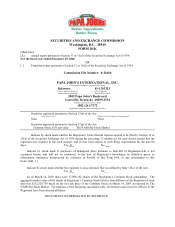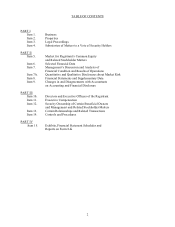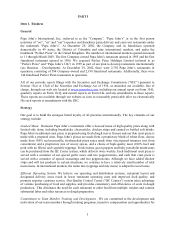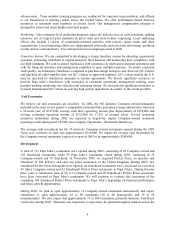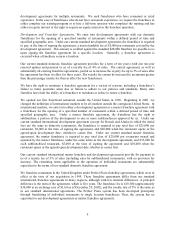Papa Johns 2002 Annual Report Download - page 5
Download and view the complete annual report
Please find page 5 of the 2002 Papa Johns annual report below. You can navigate through the pages in the report by either clicking on the pages listed below, or by using the keyword search tool below to find specific information within the annual report.4
advancement. Team member training programs are conducted for corporate team members, and offered
to our franchisees at training centers across the United States. We offer performance-based financial
incentives to restaurant team members at various levels. Our management compensation program is
designed to attract and retain highly motivated people.
Marketing. Our restaurant-level marketing programs target the delivery area of each restaurant, making
extensive use of targeted print materials in direct mail and store-to-door couponing. Local marketing
efforts also include a variety of community-oriented activities with schools, sports teams and other
organizations. Local marketing efforts are supplemented with radio and television advertising, produced
locally and on a national basis. Five national television campaigns aired in 2002.
Franchise System. We are committed to developing a strong franchise system by attracting experienced
operators, partnering with them to expand and grow their business and monitoring their compliance with
our high standards. We seek to attract franchisees with experience in multi-unit restaurant operations and
with the financial resources and management capability to open multiple locations. To ensure consistent
food quality, each domestic franchisee is required to purchase dough and spice mix from our QC Centers
and purchase all other supplies from our QC Centers or approved suppliers. QC Centers outside the U.S.
may be operated by franchisees pursuant to license agreements. We devote significant resources to
provide Papa John’s franchisees with assistance in restaurant operations, management training, team
member training, marketing, site selection and restaurant design. We also provide significant assistance to
licensed international QC Centers in sourcing high-quality ingredients in-country to the extent possible.
Unit Economics
We believe our unit economics are excellent. In 2002, the 562 domestic Company-owned restaurants
included in the most recent quarter’s comparable restaurant base generated average annual sales, based on
a 52-week year, of $747,000, average cash flow (operating income plus depreciation) of $158,000 and
average restaurant operating income of $132,000 (or 17.6% of average sales). Several restaurant
initiatives undertaken during 2002 are expected to negatively impact Company-owned restaurant
operating results during most of 2003 (see Company Operations – Restaurant Initiatives).
The average cash investment for the 10 domestic Company-owned restaurants opened during the 2002
fiscal year, exclusive of land, was approximately $250,000. We expect the average cash investment for
the Company-owned restaurants expected to open in 2003 to be approximately $260,000.
Development
A total of 113 Papa John’s restaurants were opened during 2002, consisting of 10 Company-owned and
103 franchised restaurants, while 95 Papa John’s restaurants closed during 2002, consisting of 19
Company-owned and 76 franchised. In November 1999, we acquired Perfect Pizza, an operator and
franchisor of 206 delivery and carry-out pizza restaurants in the United Kingdom. During 2002, two
franchised Perfect Pizza restaurants were opened, six franchised restaurants were closed and we converted
45 (three Company-owned and 42 franchised) Perfect Pizza restaurants to Papa John’s. During the past
three years a cumulative total of 60 (11 Company-owned and 49 franchised) Perfect Pizza restaurants
have been converted to Papa John’s restaurants. We will continue to evaluate the conversion of the
remaining 144 franchised Perfect Pizza restaurants to Papa John’s depending on financial performance
and future growth opportunities.
During 2003, we plan to open approximately 10 Company-owned restaurants domestically and expect
franchisees to open approximately 65 to 90 restaurants (30 to 40 domestically and 35 to 50
internationally). We also expect that approximately 75 to 100 restaurants, primarily domestic franchised,
could close during 2003. Domestic unit expansion is expected to be spread throughout markets across the

